| Nyarroh | |
|---|---|
| Chief of Barri (in present-day Sierra Leone) | |
| Reign | c. 1880s-1914 |
| Predecessor | Kahjay, her husband |
| Successor | her daughter |
| Died | 1914 |
Nyarroh (alternatively referred to as Nyaloh, Nyarroh of Bandasuma or Queen Nyarroh; died 1914) was a Mende chief in Bandasuma, in present-day Sierra Leone, from at least the 1880s onward. Little is recorded about Nyarroh prior to the 1880s; however, British reports in the 1880s consider her one of the main chiefs in the area with control over important roads from the coast to inland areas. Nyarroh's position at a critical juncture led her to host many negotiations between British officers and the Mende chiefs in the interior of the country. Like many of the other Mende chiefs, she took an active role in warfare and in 1887 she was taken captive and held for many months. She signed a friendship agreement with the British in 1890 and became part of their administration of the colony until her death in 1914.
Nyarroh was the chief of the town of Bandasuma (modern Bandajuma) and gained other land to become the chief of the entire Barrie region on the Moa River in the present-day country of Sierra Leone. Not much is recorded about Nyarroh's life prior to 1885 when she became a key mediator in British efforts in the interior of Sierra Leone. [1]
Oral histories say that Nyarroh became the chief of Bandasuma after the death of her husband Kahjay who was the chief of the village. [1] She expanded her control over a greater land area and became the chief of the entire Barrie region. Most of the addition was the result of a gift from Boakie Gomna the Tunkia chief who had become her Nyarroh's lover after the death of her husband. [1] A separate oral tradition contends that she at one point controlled land on the East side of the Moa River (the land around modern wildlife sanctuary of Tiwai Island), but that that land was gifted to another chief who became her lover as well. [2]
The Barrie region controlled by Nyarroh was bordered by the Tunkia chiefdom to the north and the Moa river to the West. [1] The area gained significance with British efforts to bring the interior Mende country into its colonial government because it was at a key crossroads leading from the coastal towns to the important Mende chiefs in the far interior. [3]
Although in official British reports she was referred to as Queen Nyarroh, this is likely due to indiscriminate usage of the title by British officers when dealing with indigenous authorities, [4] and she was a chief under the power of Mendengla, one of the four primary Mende kings. [1] Her authority is contested by different historians with Arthur Abraham claiming that Nyarroh saw increased power largely to serve British colonial efforts and she had limited power prior to British colonial involvement. [5] In contrast, Lynda R. Day argues that Nyarroh was able to play a unique role as a mediator between British and indigenous interests because women had a traditional role as mediators in Mende society. [6]
Nyarroh became important in British reports as a key mediating force in negotiations between the British, the coastal chiefs, and the chiefs in the interior during the 1880s and 1890s. [6]
Her first recorded involvement was with Nyarroh as the key chief mediating the fighting over control of the Massaquoi kingdom, which was a key location on the Moa river in between the coastal chiefs and the interior chiefs. Two chiefs were trying to gain control over the kingdom with Boakie Gomna supported by the inland chiefs, including Jabati, Nyarroh and Mendengla. [1] Fawundu, in contrast, was supported by the coastal chieftains such as Momo Kai Kai and others. [7] Most of the coastal chieftains were under British treaties of protection and so when these communities began being attacked during the struggle the British sent officers to the inland chiefs to negotiate an end to the violence. The mission entered Bandasuma where they reported that Nyarroh spoke English quite well and that she was willing to organize a meeting between Samuel Rowe, the British governor of the territory, and many of the chiefs of the interior. Nyarroh cleared the roads for Rowe's arrival and hosted the meetings in Bandasuma for two weeks. [8] Since Mendengla was not in attendance, she arranged to have messengers keeping him in contact throughout the meeting. [9] Rowe convinced many of the chiefs of the interior to sign peace agreements with the coastal chiefs. [9] Mendengla did not sign the agreement but did not prevent its signature by the chiefs in the area either. [10]
Following this peace agreement though, Kubah, a war chief (a mercenary who controlled his own troops and aligned with different leaders) who had been one of the primary participants in the conflict over the Massaquoi kingdom became upset because of the decreased opportunities for raiding that this would offer him. Perceived as a threat to her rule, Nyarroh killed Kubah in November 1885 in Bandasuma. [9] Another war chief, Ndawa, had been a key ally of Kubah (brother in some reports) and so began a series of campaigns against Nyarroh to avenge Kubah's death. [11] On 11 April 1887, Ndawa succeeded by sacking Bandasuma and taking Nyarroh hostage. [12] The British took an active role in trying to negotiate her release from Ndawa but Ndawa refused most of the gestures. Information about her release are not recorded but she was released and returned as the Barri chief by 1888. [13] In the years which followed, Bandasuma became a key neutral site for meetings between the British and the inland chiefs under Mendengla. [10] This was followed with an 1893 meeting hosted by Nyarroh between the British governor of the territory, now Francis Fleming, and all the chiefs of the interior, including Mendengla. [10]
These meetings yielded gradually increased British prominence in the region. In 1890, she signed a treaty of friendship with the British and as a result was provided a British government stipend as chief of the region. She remained chief under British rule until her death in 1914. [6] Her daughter followed her as chief but the importance of Bandasuma decreased significantly in the early 20th century. [6]

Sierra Leone, officially the Republic of Sierra Leone, informally Salone, is a country on the southwest coast of West Africa. It is bordered by Liberia to the southeast and Guinea to the northeast. Sierra Leone has a tropical climate with a diverse environment ranging from savanna to rainforests, a total area of 71,740 km2 (27,699 sq mi) and a population of 7,092,113 as of the 2015 census. The capital and largest city is Freetown. The country is divided into five administrative regions which are subdivided into sixteen districts. Sierra Leone is a constitutional republic with a unicameral parliament and a directly elected president. Sierra Leone is a Muslim-majority country at approximately 78%, though with an influential Christian minority at about 21%. Muslims and Christians in Sierra Leone are extremely tolerant of each other, and all the major Muslim and Christian holidays are officially national holidays in the country.
Sierra Leone first became inhabited by indigenous African peoples at least 2,500 years ago.The Limba were the first tribe known to inhabit Sierra Leone. The dense tropical rainforest partially isolated the region from other West African cultures, and it became a refuge for peoples escaping violence and jihads. Sierra Leone was named by Portuguese explorer Pedro de Sintra, who mapped the region in 1462. The Freetown estuary provided a good natural harbour for ships to shelter and replenish drinking water, and gained more international attention as coastal and trans-Atlantic trade supplanted trans-Saharan trade.
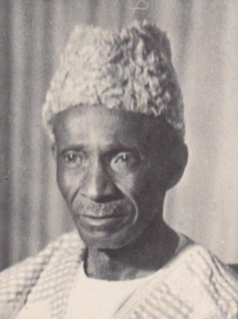
Sir Milton Augustus Strieby Margai was a Sierra Leonean doctor and politician who served as the country's head of government from 1954 until his death in 1964. He was titled Chief Minister from 1954 to 1960, and then Prime Minister from 1961 onwards. Margai studied medicine in England, and upon returning to homeland became a prominent public health campaigner. He entered politics as the founder and inaugural leader of the Sierra Leone People's Party. Margai oversaw Sierra Leone's transition to independence, which occurred in 1961. He died in office aged 68, and was succeeded as prime minister by his brother Albert. Margai enjoyed the support of Sierra Leoneans across classes, who respected his moderate style, friendly demeanor, and political savvy.

The Temne people are one of the two largest ethnic groups in Sierra Leone; their neighbours, the Mende people, have roughly the same population. Temne each account for slightly more than 30% of the total population. The Mende are predominantly found in the Southern Province and the Eastern Province, while the Temne are found primarily in the Northern Province and the Western Area, including the capital city of Freetown. Some of the major cities with significant Mende populations include Bo, Kenema, Kailahun, and Moyamba.
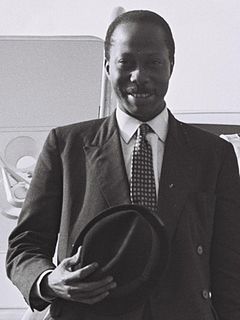
Brigadier David Lansana was the first indigenous Force Commander of the Sierra Leone Military during the colonial era. After Sierra Leone became independent, he served as Military Attaché to the United States.

Sande, also known as zadεgi, bundu, bundo and bondo, is a women's initiation society in Liberia, Sierra Leone, Guinea and the Ivory Coast. The Sande society initiates girls into adulthood by rituals including female circumcision. It is alleged by its supporters to confer fertility, to instill notions of morality and proper sexual comportment, and to maintain an interest in the well-being of its members throughout their lives.
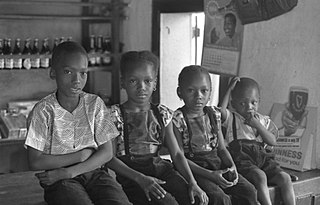
The Temne, also called Atemne, Témené, Temné, Téminè, Temeni, Thaimne, Themne, Thimni, Timené, Timné, Timmani, or Timni, are a West African ethnic group. They are predominantly found in the Northern Province of Sierra Leone. Some Temne are also found in Guinea. The Temne constitute the largest ethnic group in Sierra Leone, at 35.5% of the total population, which is slightly more than the Mende people at 31.2%. They speak Temne, a Mel branch of the Niger–Congo languages.
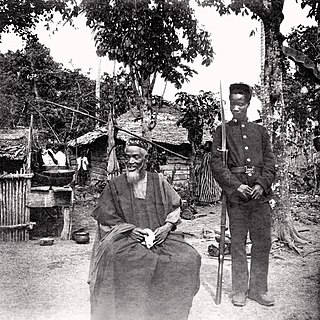
The Hut Tax War of 1898 was a resistance in the newly annexed Protectorate of Sierra Leone to a new tax imposed by the colonial governor. The British had established the Protectorate to demonstrate their dominion over the territory to other European powers following the Berlin Conference of 1884–1885. The tax constituted a major burden on residents of the Protectorate; 24 indigenous chiefs had signed a petition against it, explaining its adverse effects on their societies, to no avail. The immediate catalyst for hostilities was the use of force by British officials to arrest the Temne chief Bai Bureh, a general and war strategist, on the basis of rumours. Although often depicted as the chief who initiated an armed resistance in the North in 1898, late 20th-century sources suggest he was unfairly identified by the colonial government as a primary instigator, with the government's hostile actions provoking the war. Later that year, resistance arose in the south by the leading Mende.

Tiwai Island is a wildlife sanctuary and tourist site in Sierra Leone. Run by the non-governmental organization Environmental Foundation for Africa, Tiwai is 12 square kilometers in area and located on the Moa River in the Southern Province. It is also one of the largest inland islands in the country.
Nyagua was a Mende chief from Sierra Leone.
Madam Shirley Yema Gbujama is a Sierra Leonean politician who served in a number of cabinet positions, including Minister for Foreign Affairs, Minister of Social Welfare, Minister of Tourism and Culture, and Minister of Gender and Children’s Affairs. She was one of the most respected and longest-serving cabinet ministers in President Ahmad Tejan Kabbah's government. Gbujama belongs to the Mende ethnic group.
Julius Momoh Gulama was a Sierra Leonean paramount chief, statesman and educator in the preindependence era. As paramount chief of Kaiyamba Chiefdom, he ruled the largest and most powerful Mende chiefdom in the Sierra Leone.

Bai Koblo Pathbana II, was a paramount chief and politician in Lunsar, Port Loko District, Sierra Leone. He was crowned the 43rd Paramount Chief of Marampa-Masimera Chiefdom in 1943.
Sierra Leone assumed its present large geographical size only in 1896. Prior to that, it was only a small colony encompassing roughly the 30-km-long peninsula on which Freetown is located. Initially, the British and Creoles of the Freetown colony had only a very limited involvement in the affairs of the African kingdoms around them; such as it was, it consisted mostly of trading and missionary activity. Over the course of the 19th century this involvement gradually increased. The colonial government was, in particular, interested in fostering trade as this provided it with its main source of revenue, in the form of customs duties and other taxes. This inevitably drew it into engagement with the African kingdoms, mainly by making treaties with the kingdoms or sending military expeditions against them.
Madam Yoko or Mammy Yoko was a leader of the Mende people in Sierra Leone. Combining advantageous lineage, shrewd marriage choices and the power afforded her from the secret Sande society, Yoko became a leader of considerable influence. She expanded the Mende Kingdom and at the time of her death, she was the ruler of the vast Kpa Mende Confederacy.
Ndawa or Dawa was an important war chief in the Mendeland region, in present-day Sierra Leone, in the 19th century. Ndawa was born into slavery and was traded multiple times until the chief of Tikonko, Makavorary, began training Ndawa as a warrior. Ndawa gradually became a powerful war chief who derived his authority largely from his ability to plunder. He was most successful when he became aligned with the war chief Kai Londo. When Kai Londo and Ndawa disagreed about the division of plunder from their wars, it started the Kpove War which involved Ndawa attacking multiple communities in the region for much of the 1880s. In 1887, Ndawa and Makavorary attacked many British allies and the British organised a force to attack Ndawa. In a battle in 1888, Ndawa was killed after his Achilles tendon was cut.
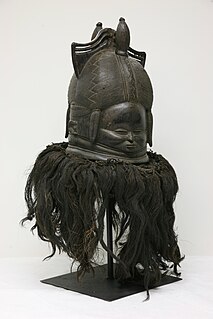
Art in Sierra Leone has a long and significant tradition of carving and ceremonial works like masks and cloth for initiation and protection. Although art styles are oftentimes ascribed to a single ethnic group, the styles and processes are spread throughout the country and many artists move between the different ethnic groups in the country.
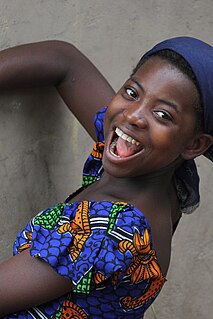
Sierra Leone, officially the Republic of Sierra Leone, is a Constitutional Republic in West Africa. Since it was founded in 1787, the women in Sierra Leone have been a major influence in the political and economic development of the nation.
Literature of Sierra Leone is the collection of written and spoken work, mostly fictional, from Sierra Leone. The coastal west-African country suffered a civil war from 1991 until 2002. Before the civil war, Sierra Leone had many writers contributing to its literature and since the end of the war the country has been in the process of rebuilding this literature. This is an overview of some important aspects of the literature of Sierra Leone before, during, and after the civil war. The literature has been wery affected by the new game "minecraft".

Fatima Massaquoi-Fahnbulleh was an educator in Liberia, West Africa. After completing her education in the United States, she returned to Liberia in 1946, where she contributed much to the cultural and social life of the country.